Business Law 1 Assignment: Contract Formation and ACL
VerifiedAdded on 2022/11/01
|11
|2418
|295
Homework Assignment
AI Summary
This Business Law 1 assignment solution analyzes a scenario involving contract formation between a customer (Stan) and a restaurant (MacBig). It examines the elements of a contract, including offer, acceptance, and consideration, in the context of ordering food from a machine and paying at the counter. The assignment also addresses the validity of an exclusion clause printed on a receipt, considering whether it was properly incorporated and whether it complies with common law principles. Furthermore, it explores whether Stan qualifies as a consumer under the Australian Consumer Law (ACL) and the rights he possesses regarding the exclusion clause, particularly concerning guarantees of safe and defect-free goods. The solution applies relevant case law and statutory provisions to support its conclusions.

Running Head: COMMERCIAL LAW 0
Business LawStudent’s Name
Business LawStudent’s Name
Paraphrase This Document
Need a fresh take? Get an instant paraphrase of this document with our AI Paraphraser
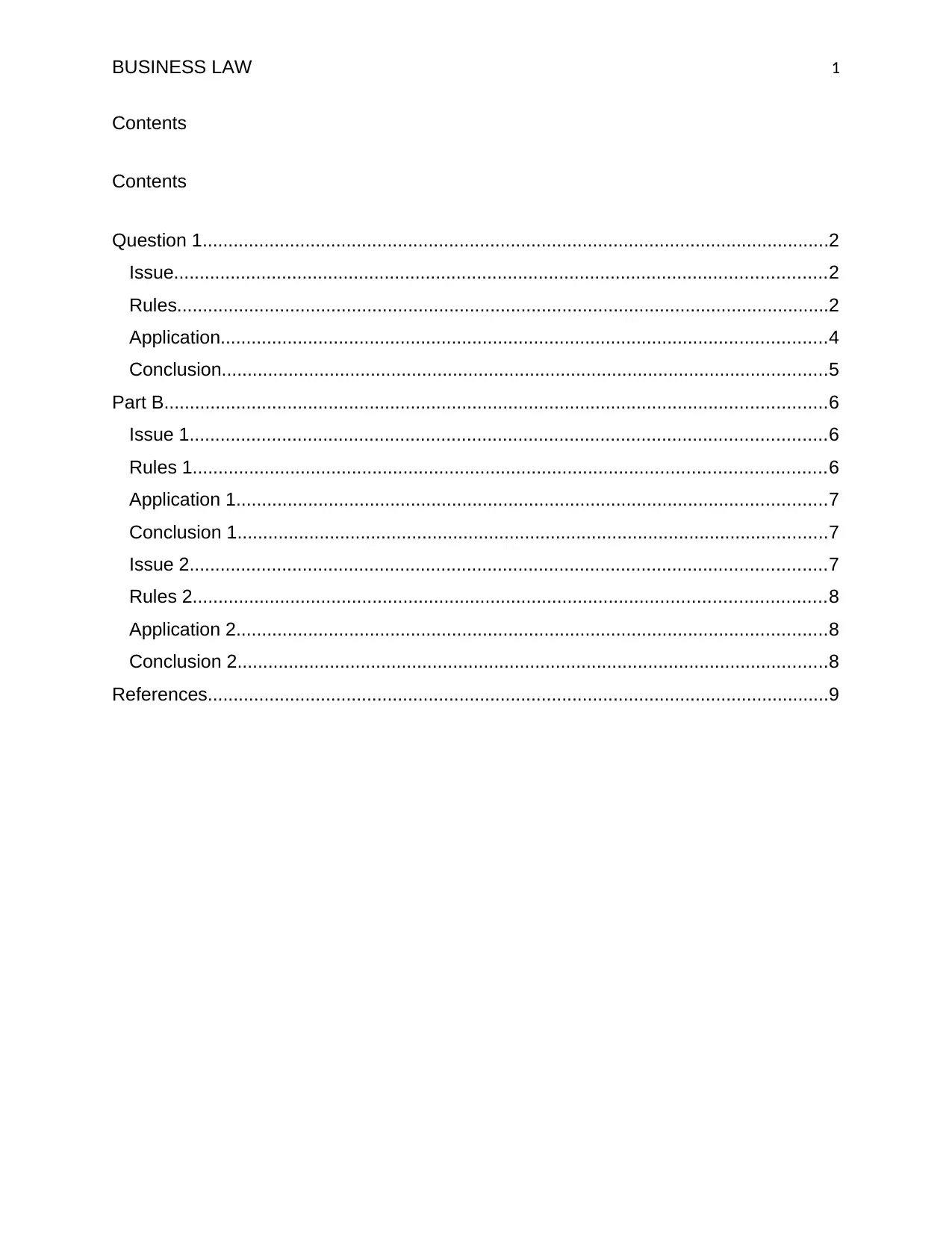
BUSINESS LAW 1
Contents
Contents
Question 1..........................................................................................................................2
Issue...............................................................................................................................2
Rules...............................................................................................................................2
Application......................................................................................................................4
Conclusion......................................................................................................................5
Part B.................................................................................................................................6
Issue 1............................................................................................................................6
Rules 1...........................................................................................................................6
Application 1...................................................................................................................7
Conclusion 1...................................................................................................................7
Issue 2............................................................................................................................7
Rules 2...........................................................................................................................8
Application 2...................................................................................................................8
Conclusion 2...................................................................................................................8
References.........................................................................................................................9
Contents
Contents
Question 1..........................................................................................................................2
Issue...............................................................................................................................2
Rules...............................................................................................................................2
Application......................................................................................................................4
Conclusion......................................................................................................................5
Part B.................................................................................................................................6
Issue 1............................................................................................................................6
Rules 1...........................................................................................................................6
Application 1...................................................................................................................7
Conclusion 1...................................................................................................................7
Issue 2............................................................................................................................7
Rules 2...........................................................................................................................8
Application 2...................................................................................................................8
Conclusion 2...................................................................................................................8
References.........................................................................................................................9

BUSINESS LAW 2
Question 1
Issue
How to contract between Stan and MacBig restaurant were formed.
Rules
Parties to the contract have the option to choose a mode of the same since contracts
developed in written as well as in oral mode are valid. In the course of the development
of contracts, different elements are needs to be there. If any of the element is missing
then an agreement remain merely an agreement and cannot turn into a contract. These
are different elements which need to present legally and validly as required under the
common law of contract. The first element is an offer which is a proposal made by one
party to another. The proposal can be related to anything like it can be for doing
something or restraint of doing the same. The one who makes it is called offeror and
another party who receives it is known as offeree. Every offer is required to contain an
intention to bind the other as decided in the Harvey v Facey [1893] UKPC 1. People
often misunderstand offer with another aspect named invitation to treat (BPP Learning
Media, 2013). The lead distinguish between these two terms is that invitation to treat do
not contain the intention to bind others whereas an offer does. An offer is available to
accept but an invitation to treat is not. The later term is an invite for the offers, in return
of which offer comes. A party who presents the invitation to treat is generally required to
consider the offers made by different parties who came across to invitation to treat and
makes offers afterward. Further, an offer is more specific and addressed to a specified
person whereas an invitation to treat is addressed to different people. The case of
Question 1
Issue
How to contract between Stan and MacBig restaurant were formed.
Rules
Parties to the contract have the option to choose a mode of the same since contracts
developed in written as well as in oral mode are valid. In the course of the development
of contracts, different elements are needs to be there. If any of the element is missing
then an agreement remain merely an agreement and cannot turn into a contract. These
are different elements which need to present legally and validly as required under the
common law of contract. The first element is an offer which is a proposal made by one
party to another. The proposal can be related to anything like it can be for doing
something or restraint of doing the same. The one who makes it is called offeror and
another party who receives it is known as offeree. Every offer is required to contain an
intention to bind the other as decided in the Harvey v Facey [1893] UKPC 1. People
often misunderstand offer with another aspect named invitation to treat (BPP Learning
Media, 2013). The lead distinguish between these two terms is that invitation to treat do
not contain the intention to bind others whereas an offer does. An offer is available to
accept but an invitation to treat is not. The later term is an invite for the offers, in return
of which offer comes. A party who presents the invitation to treat is generally required to
consider the offers made by different parties who came across to invitation to treat and
makes offers afterward. Further, an offer is more specific and addressed to a specified
person whereas an invitation to treat is addressed to different people. The case of
⊘ This is a preview!⊘
Do you want full access?
Subscribe today to unlock all pages.

Trusted by 1+ million students worldwide

BUSINESS LAW 3
Fisher v Bell [1961] 1 QB 394 is important to discuss here. In this case, there was a
knife with a price tag displayed in the shop window. Such display was not allowed under
the statue. It was provided by the court later on that goods that are displayed in a shop
amount to an invitation to treat rather than offers. An offer is required to be
communicated to the person to whom it is being made i.e. offeree (Fairgrieve, 2016).
A second important element is a consent. To amount a contract, an offeree is required
to provide his/her absolute consent to the offer of the offeror. Here absolute consent
refers to a consent that is given for the offer made by offeror without making any
changes to the same. If the consent of the offeree makes changes in any of the terms of
an offer then it is considered as counteroffer instead of an acceptance. It was given in
the decision of the case of Entorres v Miles Far East [1955] 2 QB 327 that acceptance
is also required to be communicated to the offeror. Sometimes consent can also be
given through conduct as given in the case of Butler Machine Tool v Ex-cell-o
Corporation [1979] 1 WLR 401.
Consideration is the next important element of every contract for that parties to the
contract develops the transaction in between. Every person enters into the contract for
some purpose and consideration shows such intention. Anything valuable under the law
can become s valid consideration. Consideration must be sufficient as per subject
matter and other facts of the case. In other words to say that because of the adequacy
of consideration, the validity of the same cannot be challenged. It can be non-monetary
as well. A valid consideration is the one, which moves from the promisee. It was
provided in the case of Tweddle v Atkinson [1861] EWHC QB J57 that if a person other
than a promisee gives consideration then it does not seem a valid consideration. The
Fisher v Bell [1961] 1 QB 394 is important to discuss here. In this case, there was a
knife with a price tag displayed in the shop window. Such display was not allowed under
the statue. It was provided by the court later on that goods that are displayed in a shop
amount to an invitation to treat rather than offers. An offer is required to be
communicated to the person to whom it is being made i.e. offeree (Fairgrieve, 2016).
A second important element is a consent. To amount a contract, an offeree is required
to provide his/her absolute consent to the offer of the offeror. Here absolute consent
refers to a consent that is given for the offer made by offeror without making any
changes to the same. If the consent of the offeree makes changes in any of the terms of
an offer then it is considered as counteroffer instead of an acceptance. It was given in
the decision of the case of Entorres v Miles Far East [1955] 2 QB 327 that acceptance
is also required to be communicated to the offeror. Sometimes consent can also be
given through conduct as given in the case of Butler Machine Tool v Ex-cell-o
Corporation [1979] 1 WLR 401.
Consideration is the next important element of every contract for that parties to the
contract develops the transaction in between. Every person enters into the contract for
some purpose and consideration shows such intention. Anything valuable under the law
can become s valid consideration. Consideration must be sufficient as per subject
matter and other facts of the case. In other words to say that because of the adequacy
of consideration, the validity of the same cannot be challenged. It can be non-monetary
as well. A valid consideration is the one, which moves from the promisee. It was
provided in the case of Tweddle v Atkinson [1861] EWHC QB J57 that if a person other
than a promisee gives consideration then it does not seem a valid consideration. The
Paraphrase This Document
Need a fresh take? Get an instant paraphrase of this document with our AI Paraphraser
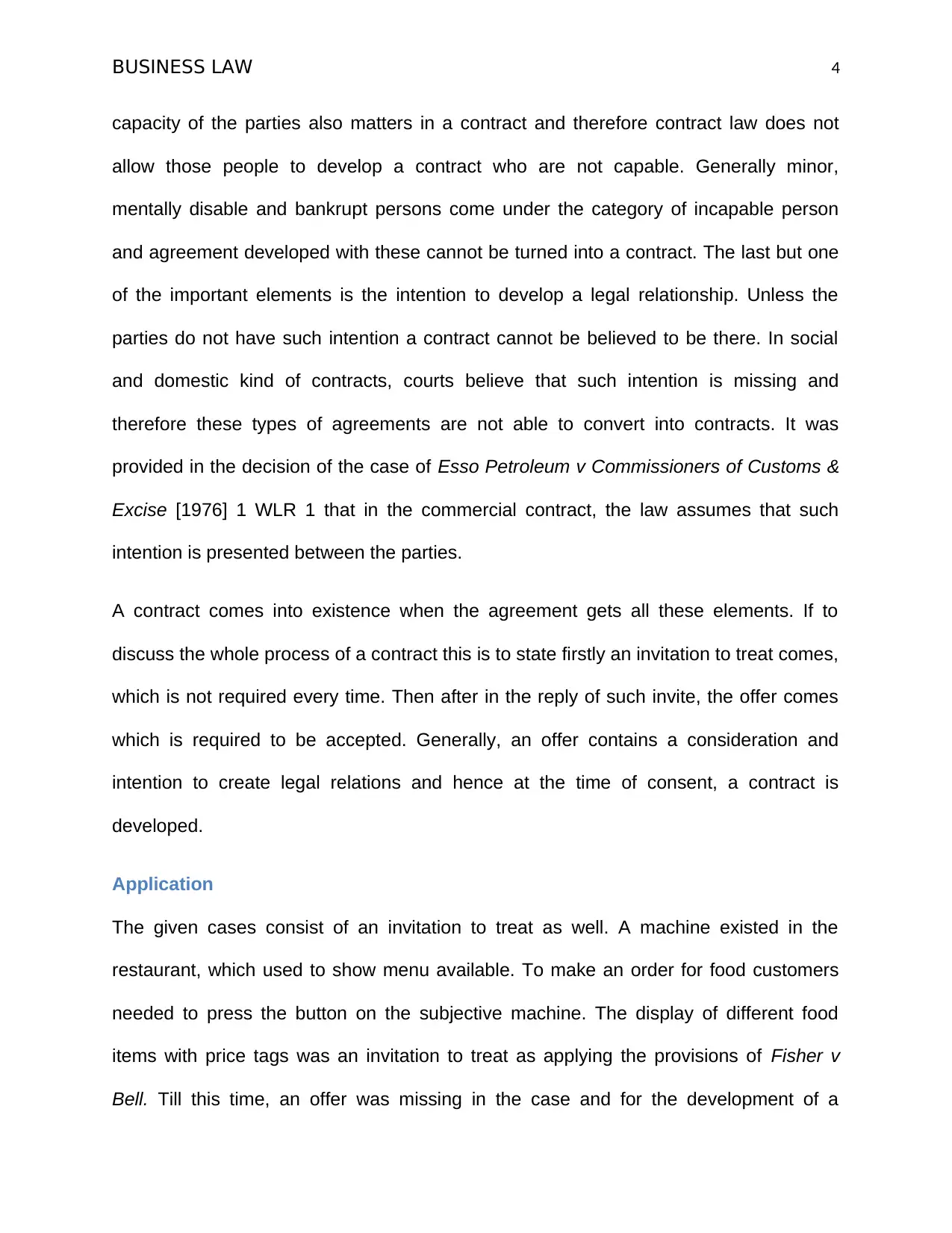
BUSINESS LAW 4
capacity of the parties also matters in a contract and therefore contract law does not
allow those people to develop a contract who are not capable. Generally minor,
mentally disable and bankrupt persons come under the category of incapable person
and agreement developed with these cannot be turned into a contract. The last but one
of the important elements is the intention to develop a legal relationship. Unless the
parties do not have such intention a contract cannot be believed to be there. In social
and domestic kind of contracts, courts believe that such intention is missing and
therefore these types of agreements are not able to convert into contracts. It was
provided in the decision of the case of Esso Petroleum v Commissioners of Customs &
Excise [1976] 1 WLR 1 that in the commercial contract, the law assumes that such
intention is presented between the parties.
A contract comes into existence when the agreement gets all these elements. If to
discuss the whole process of a contract this is to state firstly an invitation to treat comes,
which is not required every time. Then after in the reply of such invite, the offer comes
which is required to be accepted. Generally, an offer contains a consideration and
intention to create legal relations and hence at the time of consent, a contract is
developed.
Application
The given cases consist of an invitation to treat as well. A machine existed in the
restaurant, which used to show menu available. To make an order for food customers
needed to press the button on the subjective machine. The display of different food
items with price tags was an invitation to treat as applying the provisions of Fisher v
Bell. Till this time, an offer was missing in the case and for the development of a
capacity of the parties also matters in a contract and therefore contract law does not
allow those people to develop a contract who are not capable. Generally minor,
mentally disable and bankrupt persons come under the category of incapable person
and agreement developed with these cannot be turned into a contract. The last but one
of the important elements is the intention to develop a legal relationship. Unless the
parties do not have such intention a contract cannot be believed to be there. In social
and domestic kind of contracts, courts believe that such intention is missing and
therefore these types of agreements are not able to convert into contracts. It was
provided in the decision of the case of Esso Petroleum v Commissioners of Customs &
Excise [1976] 1 WLR 1 that in the commercial contract, the law assumes that such
intention is presented between the parties.
A contract comes into existence when the agreement gets all these elements. If to
discuss the whole process of a contract this is to state firstly an invitation to treat comes,
which is not required every time. Then after in the reply of such invite, the offer comes
which is required to be accepted. Generally, an offer contains a consideration and
intention to create legal relations and hence at the time of consent, a contract is
developed.
Application
The given cases consist of an invitation to treat as well. A machine existed in the
restaurant, which used to show menu available. To make an order for food customers
needed to press the button on the subjective machine. The display of different food
items with price tags was an invitation to treat as applying the provisions of Fisher v
Bell. Till this time, an offer was missing in the case and for the development of a
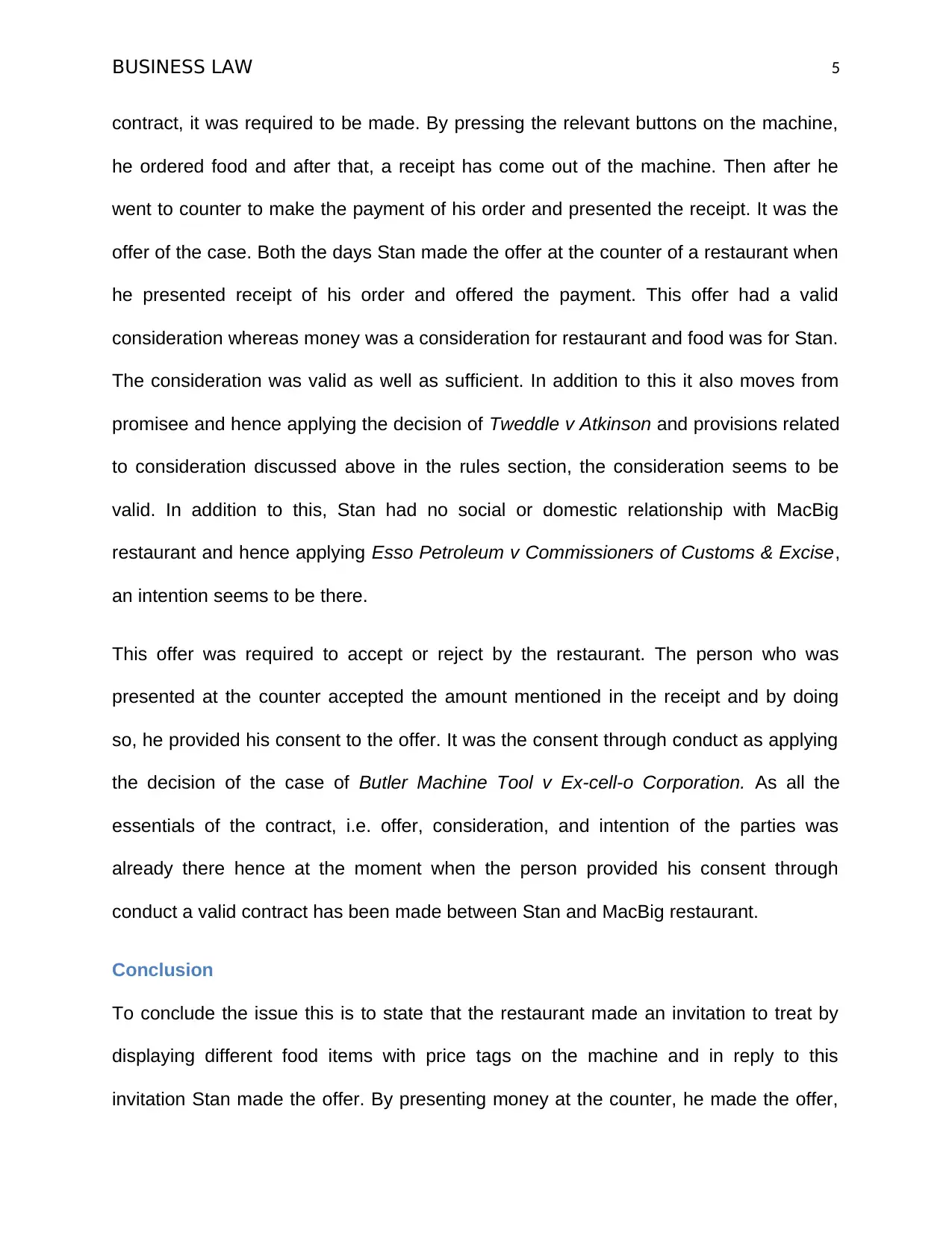
BUSINESS LAW 5
contract, it was required to be made. By pressing the relevant buttons on the machine,
he ordered food and after that, a receipt has come out of the machine. Then after he
went to counter to make the payment of his order and presented the receipt. It was the
offer of the case. Both the days Stan made the offer at the counter of a restaurant when
he presented receipt of his order and offered the payment. This offer had a valid
consideration whereas money was a consideration for restaurant and food was for Stan.
The consideration was valid as well as sufficient. In addition to this it also moves from
promisee and hence applying the decision of Tweddle v Atkinson and provisions related
to consideration discussed above in the rules section, the consideration seems to be
valid. In addition to this, Stan had no social or domestic relationship with MacBig
restaurant and hence applying Esso Petroleum v Commissioners of Customs & Excise,
an intention seems to be there.
This offer was required to accept or reject by the restaurant. The person who was
presented at the counter accepted the amount mentioned in the receipt and by doing
so, he provided his consent to the offer. It was the consent through conduct as applying
the decision of the case of Butler Machine Tool v Ex-cell-o Corporation. As all the
essentials of the contract, i.e. offer, consideration, and intention of the parties was
already there hence at the moment when the person provided his consent through
conduct a valid contract has been made between Stan and MacBig restaurant.
Conclusion
To conclude the issue this is to state that the restaurant made an invitation to treat by
displaying different food items with price tags on the machine and in reply to this
invitation Stan made the offer. By presenting money at the counter, he made the offer,
contract, it was required to be made. By pressing the relevant buttons on the machine,
he ordered food and after that, a receipt has come out of the machine. Then after he
went to counter to make the payment of his order and presented the receipt. It was the
offer of the case. Both the days Stan made the offer at the counter of a restaurant when
he presented receipt of his order and offered the payment. This offer had a valid
consideration whereas money was a consideration for restaurant and food was for Stan.
The consideration was valid as well as sufficient. In addition to this it also moves from
promisee and hence applying the decision of Tweddle v Atkinson and provisions related
to consideration discussed above in the rules section, the consideration seems to be
valid. In addition to this, Stan had no social or domestic relationship with MacBig
restaurant and hence applying Esso Petroleum v Commissioners of Customs & Excise,
an intention seems to be there.
This offer was required to accept or reject by the restaurant. The person who was
presented at the counter accepted the amount mentioned in the receipt and by doing
so, he provided his consent to the offer. It was the consent through conduct as applying
the decision of the case of Butler Machine Tool v Ex-cell-o Corporation. As all the
essentials of the contract, i.e. offer, consideration, and intention of the parties was
already there hence at the moment when the person provided his consent through
conduct a valid contract has been made between Stan and MacBig restaurant.
Conclusion
To conclude the issue this is to state that the restaurant made an invitation to treat by
displaying different food items with price tags on the machine and in reply to this
invitation Stan made the offer. By presenting money at the counter, he made the offer,
⊘ This is a preview!⊘
Do you want full access?
Subscribe today to unlock all pages.

Trusted by 1+ million students worldwide
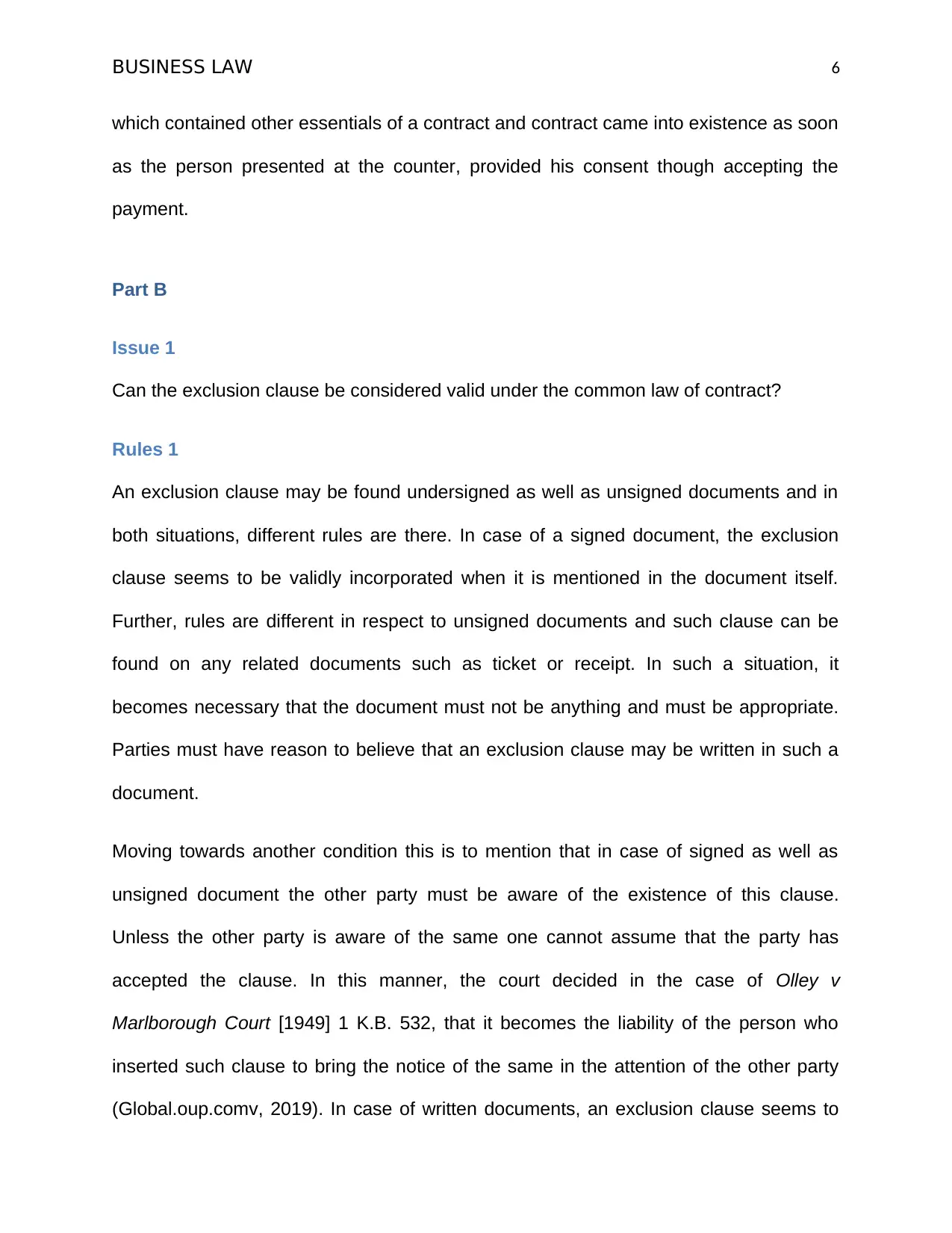
BUSINESS LAW 6
which contained other essentials of a contract and contract came into existence as soon
as the person presented at the counter, provided his consent though accepting the
payment.
Part B
Issue 1
Can the exclusion clause be considered valid under the common law of contract?
Rules 1
An exclusion clause may be found undersigned as well as unsigned documents and in
both situations, different rules are there. In case of a signed document, the exclusion
clause seems to be validly incorporated when it is mentioned in the document itself.
Further, rules are different in respect to unsigned documents and such clause can be
found on any related documents such as ticket or receipt. In such a situation, it
becomes necessary that the document must not be anything and must be appropriate.
Parties must have reason to believe that an exclusion clause may be written in such a
document.
Moving towards another condition this is to mention that in case of signed as well as
unsigned document the other party must be aware of the existence of this clause.
Unless the other party is aware of the same one cannot assume that the party has
accepted the clause. In this manner, the court decided in the case of Olley v
Marlborough Court [1949] 1 K.B. 532, that it becomes the liability of the person who
inserted such clause to bring the notice of the same in the attention of the other party
(Global.oup.comv, 2019). In case of written documents, an exclusion clause seems to
which contained other essentials of a contract and contract came into existence as soon
as the person presented at the counter, provided his consent though accepting the
payment.
Part B
Issue 1
Can the exclusion clause be considered valid under the common law of contract?
Rules 1
An exclusion clause may be found undersigned as well as unsigned documents and in
both situations, different rules are there. In case of a signed document, the exclusion
clause seems to be validly incorporated when it is mentioned in the document itself.
Further, rules are different in respect to unsigned documents and such clause can be
found on any related documents such as ticket or receipt. In such a situation, it
becomes necessary that the document must not be anything and must be appropriate.
Parties must have reason to believe that an exclusion clause may be written in such a
document.
Moving towards another condition this is to mention that in case of signed as well as
unsigned document the other party must be aware of the existence of this clause.
Unless the other party is aware of the same one cannot assume that the party has
accepted the clause. In this manner, the court decided in the case of Olley v
Marlborough Court [1949] 1 K.B. 532, that it becomes the liability of the person who
inserted such clause to bring the notice of the same in the attention of the other party
(Global.oup.comv, 2019). In case of written documents, an exclusion clause seems to
Paraphrase This Document
Need a fresh take? Get an instant paraphrase of this document with our AI Paraphraser
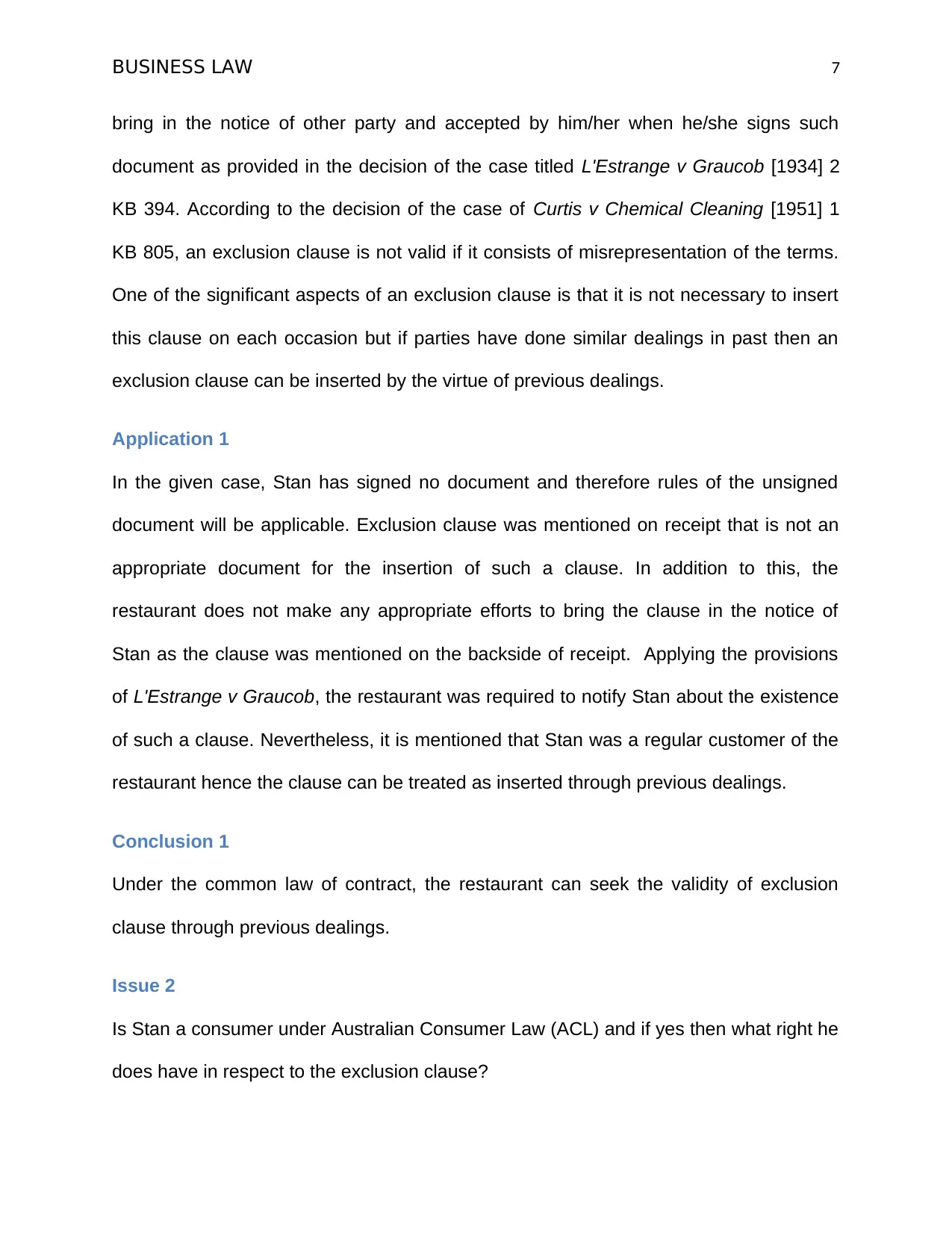
BUSINESS LAW 7
bring in the notice of other party and accepted by him/her when he/she signs such
document as provided in the decision of the case titled L'Estrange v Graucob [1934] 2
KB 394. According to the decision of the case of Curtis v Chemical Cleaning [1951] 1
KB 805, an exclusion clause is not valid if it consists of misrepresentation of the terms.
One of the significant aspects of an exclusion clause is that it is not necessary to insert
this clause on each occasion but if parties have done similar dealings in past then an
exclusion clause can be inserted by the virtue of previous dealings.
Application 1
In the given case, Stan has signed no document and therefore rules of the unsigned
document will be applicable. Exclusion clause was mentioned on receipt that is not an
appropriate document for the insertion of such a clause. In addition to this, the
restaurant does not make any appropriate efforts to bring the clause in the notice of
Stan as the clause was mentioned on the backside of receipt. Applying the provisions
of L'Estrange v Graucob, the restaurant was required to notify Stan about the existence
of such a clause. Nevertheless, it is mentioned that Stan was a regular customer of the
restaurant hence the clause can be treated as inserted through previous dealings.
Conclusion 1
Under the common law of contract, the restaurant can seek the validity of exclusion
clause through previous dealings.
Issue 2
Is Stan a consumer under Australian Consumer Law (ACL) and if yes then what right he
does have in respect to the exclusion clause?
bring in the notice of other party and accepted by him/her when he/she signs such
document as provided in the decision of the case titled L'Estrange v Graucob [1934] 2
KB 394. According to the decision of the case of Curtis v Chemical Cleaning [1951] 1
KB 805, an exclusion clause is not valid if it consists of misrepresentation of the terms.
One of the significant aspects of an exclusion clause is that it is not necessary to insert
this clause on each occasion but if parties have done similar dealings in past then an
exclusion clause can be inserted by the virtue of previous dealings.
Application 1
In the given case, Stan has signed no document and therefore rules of the unsigned
document will be applicable. Exclusion clause was mentioned on receipt that is not an
appropriate document for the insertion of such a clause. In addition to this, the
restaurant does not make any appropriate efforts to bring the clause in the notice of
Stan as the clause was mentioned on the backside of receipt. Applying the provisions
of L'Estrange v Graucob, the restaurant was required to notify Stan about the existence
of such a clause. Nevertheless, it is mentioned that Stan was a regular customer of the
restaurant hence the clause can be treated as inserted through previous dealings.
Conclusion 1
Under the common law of contract, the restaurant can seek the validity of exclusion
clause through previous dealings.
Issue 2
Is Stan a consumer under Australian Consumer Law (ACL) and if yes then what right he
does have in respect to the exclusion clause?

BUSINESS LAW 8
Rules 2
Every person who buy goods or avail services for domestic use where the amount of
the same is less than $40000 then a person is considered as a consumer under ACL.
Different guarantees are given under ACL regarding goods and services to provide
safeguard to the interest of consumers. Section 54 of ACL provides that any goods
provided to the consumer must be of safe and free from defects (Accc.gov.au, 2019). A
consumer has the right to sue goods seller if he/she breaches this guarantee. Further
as per the provisions of section 64, every exclusion clause, which contradicts any
statutory guarantee, seems to be invalid.
Application 2
As per the definition of the consumer given under ACL, Stan was a consumer as he
brought hand-cut chips and gourmet burger for domestic use and value of the same
was only $17.5. Further, here the guarantee of section 54 was applicable and the
restaurant was required to provide safe and defect-free goods to Stan.s. As exclusion
clause cancel out this liability, therefore, the same is invalid as per provisions of section
64 of ACL.
Conclusion 2
The clause is not valid under ACL and Stan has right to sue a restaurant for breach of
consumer guarantee mentioned under section 54.
Rules 2
Every person who buy goods or avail services for domestic use where the amount of
the same is less than $40000 then a person is considered as a consumer under ACL.
Different guarantees are given under ACL regarding goods and services to provide
safeguard to the interest of consumers. Section 54 of ACL provides that any goods
provided to the consumer must be of safe and free from defects (Accc.gov.au, 2019). A
consumer has the right to sue goods seller if he/she breaches this guarantee. Further
as per the provisions of section 64, every exclusion clause, which contradicts any
statutory guarantee, seems to be invalid.
Application 2
As per the definition of the consumer given under ACL, Stan was a consumer as he
brought hand-cut chips and gourmet burger for domestic use and value of the same
was only $17.5. Further, here the guarantee of section 54 was applicable and the
restaurant was required to provide safe and defect-free goods to Stan.s. As exclusion
clause cancel out this liability, therefore, the same is invalid as per provisions of section
64 of ACL.
Conclusion 2
The clause is not valid under ACL and Stan has right to sue a restaurant for breach of
consumer guarantee mentioned under section 54.
⊘ This is a preview!⊘
Do you want full access?
Subscribe today to unlock all pages.

Trusted by 1+ million students worldwide
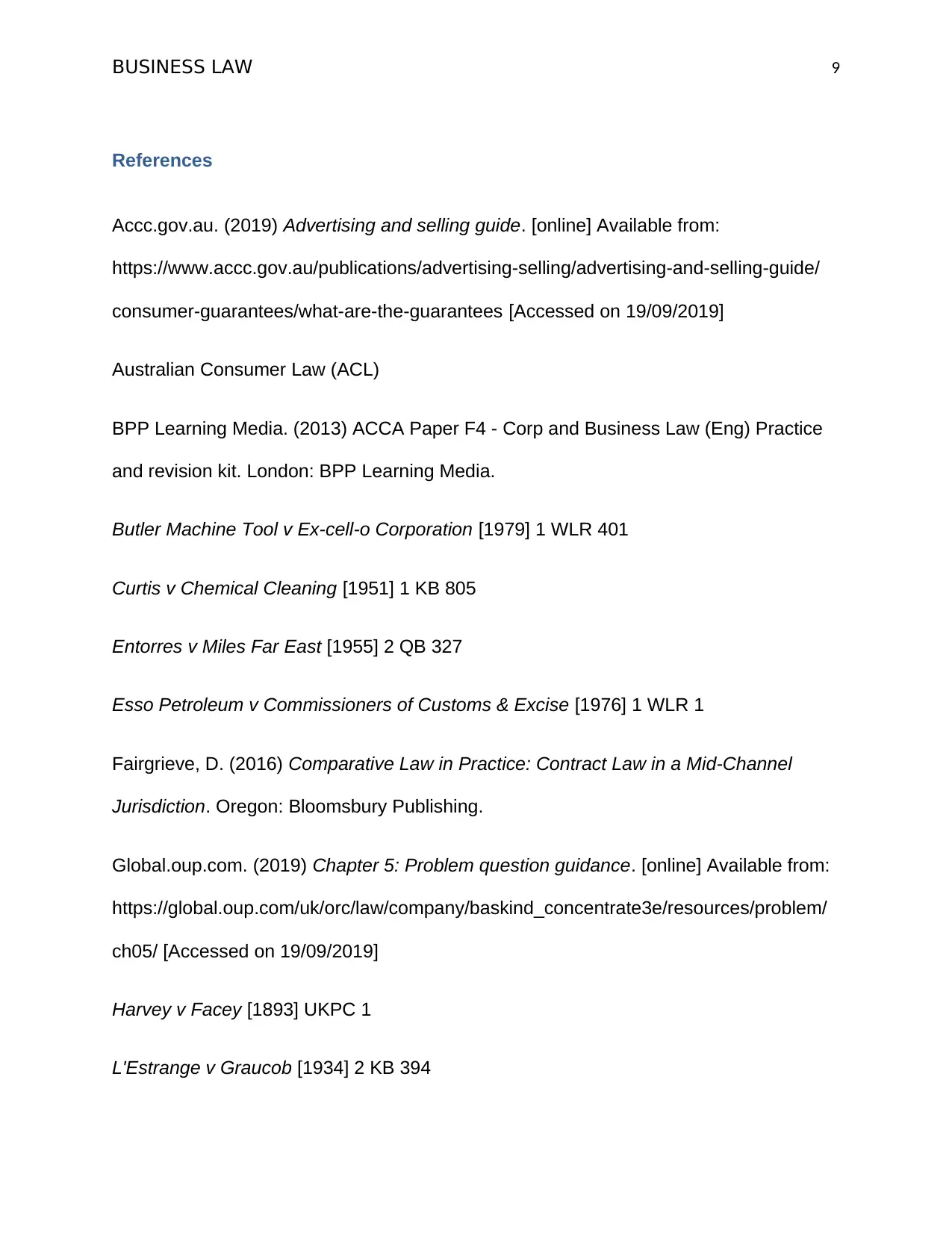
BUSINESS LAW 9
References
Accc.gov.au. (2019) Advertising and selling guide. [online] Available from:
https://www.accc.gov.au/publications/advertising-selling/advertising-and-selling-guide/
consumer-guarantees/what-are-the-guarantees [Accessed on 19/09/2019]
Australian Consumer Law (ACL)
BPP Learning Media. (2013) ACCA Paper F4 - Corp and Business Law (Eng) Practice
and revision kit. London: BPP Learning Media.
Butler Machine Tool v Ex-cell-o Corporation [1979] 1 WLR 401
Curtis v Chemical Cleaning [1951] 1 KB 805
Entorres v Miles Far East [1955] 2 QB 327
Esso Petroleum v Commissioners of Customs & Excise [1976] 1 WLR 1
Fairgrieve, D. (2016) Comparative Law in Practice: Contract Law in a Mid-Channel
Jurisdiction. Oregon: Bloomsbury Publishing.
Global.oup.com. (2019) Chapter 5: Problem question guidance. [online] Available from:
https://global.oup.com/uk/orc/law/company/baskind_concentrate3e/resources/problem/
ch05/ [Accessed on 19/09/2019]
Harvey v Facey [1893] UKPC 1
L'Estrange v Graucob [1934] 2 KB 394
References
Accc.gov.au. (2019) Advertising and selling guide. [online] Available from:
https://www.accc.gov.au/publications/advertising-selling/advertising-and-selling-guide/
consumer-guarantees/what-are-the-guarantees [Accessed on 19/09/2019]
Australian Consumer Law (ACL)
BPP Learning Media. (2013) ACCA Paper F4 - Corp and Business Law (Eng) Practice
and revision kit. London: BPP Learning Media.
Butler Machine Tool v Ex-cell-o Corporation [1979] 1 WLR 401
Curtis v Chemical Cleaning [1951] 1 KB 805
Entorres v Miles Far East [1955] 2 QB 327
Esso Petroleum v Commissioners of Customs & Excise [1976] 1 WLR 1
Fairgrieve, D. (2016) Comparative Law in Practice: Contract Law in a Mid-Channel
Jurisdiction. Oregon: Bloomsbury Publishing.
Global.oup.com. (2019) Chapter 5: Problem question guidance. [online] Available from:
https://global.oup.com/uk/orc/law/company/baskind_concentrate3e/resources/problem/
ch05/ [Accessed on 19/09/2019]
Harvey v Facey [1893] UKPC 1
L'Estrange v Graucob [1934] 2 KB 394
Paraphrase This Document
Need a fresh take? Get an instant paraphrase of this document with our AI Paraphraser
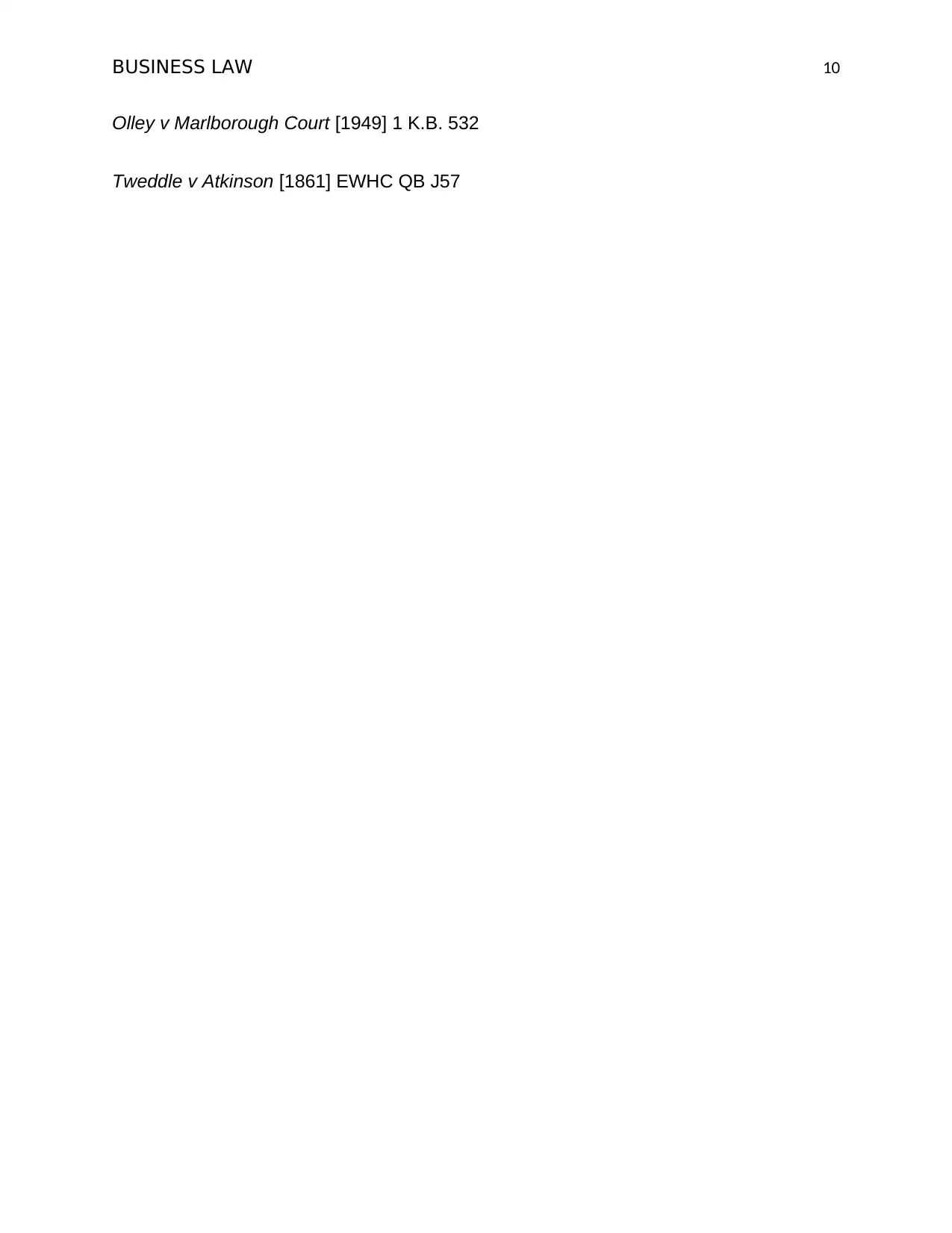
BUSINESS LAW 10
Olley v Marlborough Court [1949] 1 K.B. 532
Tweddle v Atkinson [1861] EWHC QB J57
Olley v Marlborough Court [1949] 1 K.B. 532
Tweddle v Atkinson [1861] EWHC QB J57
1 out of 11
Related Documents
Your All-in-One AI-Powered Toolkit for Academic Success.
+13062052269
info@desklib.com
Available 24*7 on WhatsApp / Email
![[object Object]](/_next/static/media/star-bottom.7253800d.svg)
Unlock your academic potential
Copyright © 2020–2025 A2Z Services. All Rights Reserved. Developed and managed by ZUCOL.





